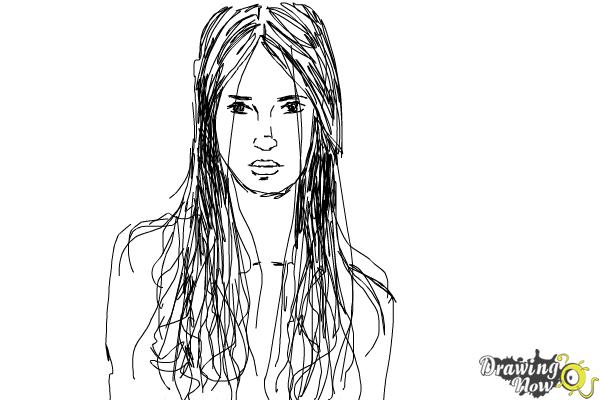Wet hair draw drawing coloring drawingnow paintingvalley
Table of Contents
Table of Contents
Have you ever tried to draw wet hair and found it challenging? Perhaps you’ve struggled to capture the way the strands clump together or the way they glisten in the light. Don’t worry; you’re not alone. Drawing wet hair is a common pain point for many artists, but with a few techniques and some practice, anyone can learn how to master this skill.
Common Challenges of Drawing Wet Hair
One challenge that artists often face when drawing wet hair is capturing its texture accurately. Wet hair clumps together in strands and has a shiny, reflective quality that can be difficult to recreate. Another challenge is getting the flow of the hair right. Depending on the length and style, wet hair can lay flat or cling to the head in different ways.
How to Draw Wet Hair
The key to drawing wet hair is to pay attention to the highlights and shadows that give it its unique texture. Start by sketching out the basic shape of the hair and then adding in the individual strands. Use a reference photo or real-world observation to get a sense of how the hair should flow. To create the wet effect, use shading techniques to add highlights where the hair is wettest and shadows where it is driest. Experiment with different types of pencils or digital brushes to achieve the desired effect.
Summary
In summary, drawing wet hair can be a challenge, but with practice and patience, anyone can master this skill. To get started, pay attention to the texture and flow of wet hair, use reference photos or observation, and experiment with shading techniques to create highlights and shadows. With these techniques in mind, you’ll be able to draw wet hair with ease and accuracy.
How to Draw Wet Hair: Techniques and Tips
When I first started drawing wet hair, I struggled to capture the texture and flow of the strands. But with some experimentation and practice, I discovered a few techniques that made the process much easier. One of the most important things I learned is to start with a basic sketch of the hair and then add in the individual strands. This helps to establish the flow of the hair and gives you a foundation to work from.
 Next, pay close attention to the highlights and shadows in the hair. Wet hair is reflective, so it tends to have areas of lighter and darker shading that give it its distinctive texture. Use a pencil or digital brush to create highlights where the hair is wettest and shadows where it is driest.
Next, pay close attention to the highlights and shadows in the hair. Wet hair is reflective, so it tends to have areas of lighter and darker shading that give it its distinctive texture. Use a pencil or digital brush to create highlights where the hair is wettest and shadows where it is driest.
Another tip is to observe how the hair flows when wet. Depending on the style and length, wet hair can lay flat, stick together in clumps, or cling to the head in different ways. Try to capture this flow in your drawing to make the hair look as realistic as possible.
Materials for Drawing Wet Hair
To draw wet hair effectively, you’ll need a few key materials. A high-quality pencil or set of digital brushes is essential for creating accurate shading and highlights. You may also want to use a reference photo or model to help you capture the flow and texture of the hair. Finally, don’t forget to use good quality paper or digital canvas to create your masterpiece.
Different Styles of Wet Hair
Depending on the length and style of the hair, there are different techniques you can use to draw wet hair effectively. For short hair, focus on creating individual clumps that stick together. For medium-length hair, try to capture the way the hair flows and clumps together. For long hair, create a sense of weight and movement by adding more shading and highlights to the lower sections of the hair.
Question and Answer
Q: How do I make the hair look wet?
A: To make the hair look wet, focus on adding highlights where the hair is wettest and shadows where it is driest. This will give it a reflective quality that looks like it has recently been washed or is damp from being outside in the rain.
Q: What types of pencils or brushes are best for drawing wet hair?
A: The type of pencil or brush you use will depend on your personal preferences and the medium you are working with. However, many artists find that softer pencils or digital brushes with a gradient tool work well for creating the texture and shading of wet hair.
Q: How do I capture the flow of wet hair in my drawing?
A: To capture the flow of wet hair, observe how the hair moves and clumps together when wet. Use shading techniques to create areas of light and darkness that highlight the way the hair flows and clumps together. Experiment with different techniques until you find the one that works best for you.
Q: What are some common mistakes to avoid when drawing wet hair?
A: One common mistake when drawing wet hair is to make the highlights too bright or the shadows too dark. Another mistake is to forget about the flow of the hair and make it look stiff or clumpy. To avoid these mistakes, study reference photos or real-world observation and practice your shading techniques until you achieve the desired effect.
Conclusion of How to Draw Wet Hair
Drawing wet hair can be a challenge, but with these techniques and tips, anyone can learn how to master this skill. The key is to pay attention to the highlights and shadows that give wet hair its unique texture and to observe how the hair flows in different styles and lengths. With these tips in mind, you’ll be on your way to creating beautiful and realistic drawings of wet hair in no time.
Gallery
Wet Hair #stephlew #photoshop #dailydoodle | Art Reference Poses

Photo Credit by: bing.com / dailydoodle
Wet Hair Drawing | Free Download On ClipArtMag

Photo Credit by: bing.com / clipartmag
How To Draw Wet Hair - DrawingNow

Photo Credit by: bing.com / wet hair draw drawing coloring drawingnow paintingvalley
How To…draw Wet Hair By AmeDvleec On DeviantArt

Photo Credit by: bing.com / wet hair draw drawing deviantart expressions facial poster digital drawings
How To Draw Wet Hair - YouTube

Photo Credit by: bing.com / wet hair draw






